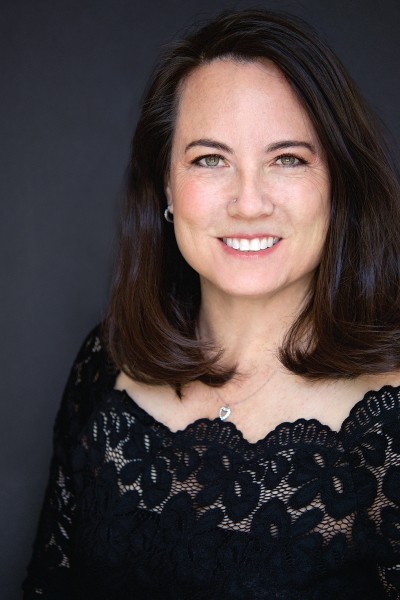Consumer-centric marketing for photographers
Headshot photographer Glynns Thomas spent 30 years in marketing. She shares branding advice with photographers.
• July 2019 issue
Name youR hero
For 30 years, Glynns Thomas built her reputation as a marketing all-star while working for some of the world’s best-known advertising agencies. Her accounts included Hilton Hotels, Princess Cruises, American Airlines, Infiniti Motors, and Bank of America, to name a few. Today, she teaches her favorite corporate advertising strategies to small business owners while running her own small business focused on headshot and branding photography.
This dual experience has allowed Thomas to distill lessons photographers can use to market their businesses in a more consumer-centric way.

Always be marketing
Photographers need to make marketing a part of their daily lives, says Thomas. If not daily, then certainly weekly at a minimum. “A lot of small business owners don’t see marketing as part of daily business life,” she observes. “They are just finding out that they are a business owner first and a photographer second.” Taking a business-first philosophy and committing to marketing are critical to success.
Use customer-focused language
Know your audience and speak to them on their terms. Too often the messaging photographers disseminate on their website, in social media, and in other promotions touts how good they are and all that they offer. Instead, be customer-focused in your approach and less product-focused, suggests Thomas. That shift can be as simple as the difference between “I create award-winning family portraits” and “Your family deserves a portrait that can be enjoyed for generations.”
Think about your ideal customers, and then create products, communications, and marketing around them. “Once I have that strategy in place and written down, I can always refer to it,” she says. “That helps me stay organized and make sure that I’m not missing something.”
Find your hero
Writing down a strategic marketing plan sounds like a great idea, but where do you start? To make the process relatable, Thomas likes to put it into the context of the hero’s journey. You may remember the concept from a long-ago literature class in school: A hero goes on an adventure, faces a crisis, wins a victory, and returns home transformed. Use the hero’s journey to frame how your ideal customer navigates your marketing process.
“When you’re thinking about your target audience, who’s the hero of the story, and what’s their problem?” asks Thomas. “Figure out the fundamental challenge that your hero faces as it relates to your work. Then overlay the purchase decision cycle on top of the hero’s journey.” To do this, Thomas suggests asking yourself:
Who is my hero? What is the personality profile of your ideal customer? Write out descriptions, demographics, psychographics. You might have multiple heroes for different aspects of your business. For example, your high school portrait clients may be leagues apart from your wedding couples. Describe each hero in no more than one page. Once you’ve completed these descriptions, don’t let them get dusty. Refer to them and update as needed.
- Where do I find my hero? Where in the physical world as well as the virtual realm does your hero hang out and interact with others? Figure out how to reach your hero in these places.
- What resonates with my hero? What does this person care about? What are their struggles and how can you help solve them?
- What is my hero’s buy-in journey? What purchase decision cycle will your hero go through?
- What can I do to get noticed? How do you get your hero to take notice of you among everything else in their busy life?
- What transformation do I promise? What are you saying to the hero? What are you doing to get the hero to move to the next stage? What are your goals? Are you trying to schedule a consultation, for example? If so, then how can you encourage this next step?
- How do I call the hero to action again? What can you do to encourage your hero to come back and offer repeat business?
- How will my hero help me recruit others? How will you use past customers to recruit referrals? What can your hero do to help promote you?
Write your brand story
You’ve identified your hero. Now you need to communicate with that ideal customer. Thomas suggests writing out a communications brief to help organize your work. She likes to start this process by putting her photographic work into different categories then creating communications that revolve around those segments. For example, Thomas specializes in headshots, so she has a category of marketing communications that’s formulated specifically for people who want to advance their careers in corporate environments. That gives her a direction, a starting point for brainstorming, and some inspiration for social posts, case studies, blog posts, tip lists, and other materials.
Once this brief is established, look at all your marketing to ensure everything is consistent. Is your audience getting a cohesive message across all your materials, including your website, social media, email, and print collateral?
When an idea for a new post or marketing piece pops up, Thomas records it in a marketing calendar, which serves as a repository for ideas she can loosely schedule months in advance. “When you write to the categories, to your specialties, and plan things out in advance, you’ll come up with more ideas than you ever thought possible,” she says.

Add layers
Most small businesses take a shotgun approach to marketing: scattered efforts across multiple areas to see what works. However, if you’re going to be in business for a while, you’ll need a strategic plan where one marketing activity builds on another.
That’s where the concept of layering comes in. Rather than scattering your efforts into the wind to see what blows back to you, start small with just one to three things. Get those activities dialed in, and then layer on. Start with a priority list and establish ideas of how to build on those first priorities
with additional layers. Remember, good marketing is an iterative process, so step one sets up step two, which sets up step three, and so on.
Think of this layering process as similar to the way you learned photography. You probably started by taking snapshots, then experimented with setting adjustments, then learned some advanced techniques. It’s the same with marketing. Learn it step by step, upping your game as you proceed.
Not for everyone
Instead of marketing based on products, market based on why someone would choose you. “It’s not a matter of always being the best choice because you’re not going to be the best choice for everyone,” says Thomas. “It’s more about being the best choice for the specific group you’re targeting.”
How do you show you’re the best choice for this group? Play to your strengths, says Thomas. Find out what clients enjoy about their experience working with you and promote it. For example, if you see that your clients get a lot of joy from the photo session itself, then show prospects what that experience is like. Display behind-the-scenes images of people having fun, publish testimonials, seek out referrals from your happiest clients.
Trust the process
Becoming a good marketer is a process. A lot of people believe that if they do one thing right, the sales will follow. “There are too many articles that make it seem like there’s a magic marketing solution that will make everything work,” says Thomas.
“Good marketing is not an overnight success story. It is a process. You form your plan. You prioritize and organize. You take your next step, and then your next. You always have to have that next step. Then, after a while moving in the right direction, good things happen.”
Jeff Kent is the editor-at-large of Professional Photographer.



